Plant Cell: Plant cells are a type of eukaryotic cells that have a genuine nucleus as well as specialized components or organelles that perform specific functions for plants. Plant cells are distinguished from other creatures’ cells by their cell walls, chloroplasts, and central vacuole. The plant cell is surrounded by a cell wall, which gives it shape. The plant cell has various components, including the cell wall, each of which serves a different purpose. Read the entire article to learn more about all plant cell organelles and plant cell types, as well as their functions.
Plant Cell Class 9
Plants, like animals and humans, are made up of an endless number of cells. It is the plant’s structural and functional unit. Robert Hooke, an English natural philosopher, was the first to observe plant cells. He was capable of seeing plant cells from a bottle cork sample thanks to the availability of a microscope.
Plant Cell Definition
Plant cells are thought to have originated from early green algae and appeared for the first time more than 500 million years ago. Robert Hooke discovered small pores in bottle cork samples resembling honeycombs. To describe these tiny apertures, he invented the name cells. He initially mistook them for empty cells. Scientists were able to view the live components of plants thanks to the accessibility of more powerful microscopes. A basic plant cell often has membrane-bound cell components called organelles that remain floating in the cytoplasm.
Plant Cell Diagram
Let’s take a closer look at each of the Plant Cell elements in the given Plant Cell diagram representation.
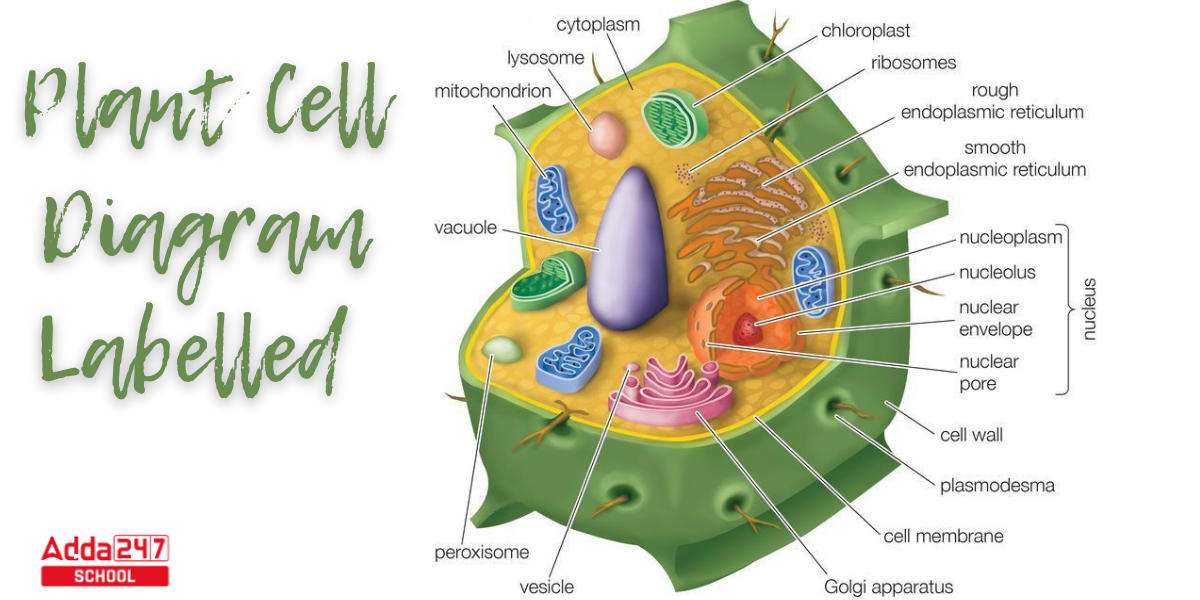
Plant Cell Types
Plant cells generate five types of tissue, each having a distinct purpose so we can say there are 5 Plant Cell Types. Simple plant tissues, such as parenchyma, collenchyma, and sclerenchyma, all have a single-cell type. In contrast, the xylem and phloem are complex tissues that contain a variety of cell types.
Parenchyma Cells
The bulk of cells in a plant is found in parenchyma tissue. Because they are thinner, these cells are more flexible than others. They are located in leaves and perform photosynthesis. They are also involved in gas exchange, organic product storage, and cell metabolism. They also store chemicals such as carbohydrates and proteins and aid in plant wound healing.
Sclerenchyma
Sclerenchyma tissue comprises rigid cells that serve as the primary supporting cells in plant parts that have stopped developing. These cells tend to appear in all plant roots and are primarily responsible for plant support. Sclerenchyma cells are dead with thick cell walls.
Collenchyma
Collenchyma tissue supports the growth of plant components. They are long and have thick cell walls, and they can expand and change their structure as the plant does.
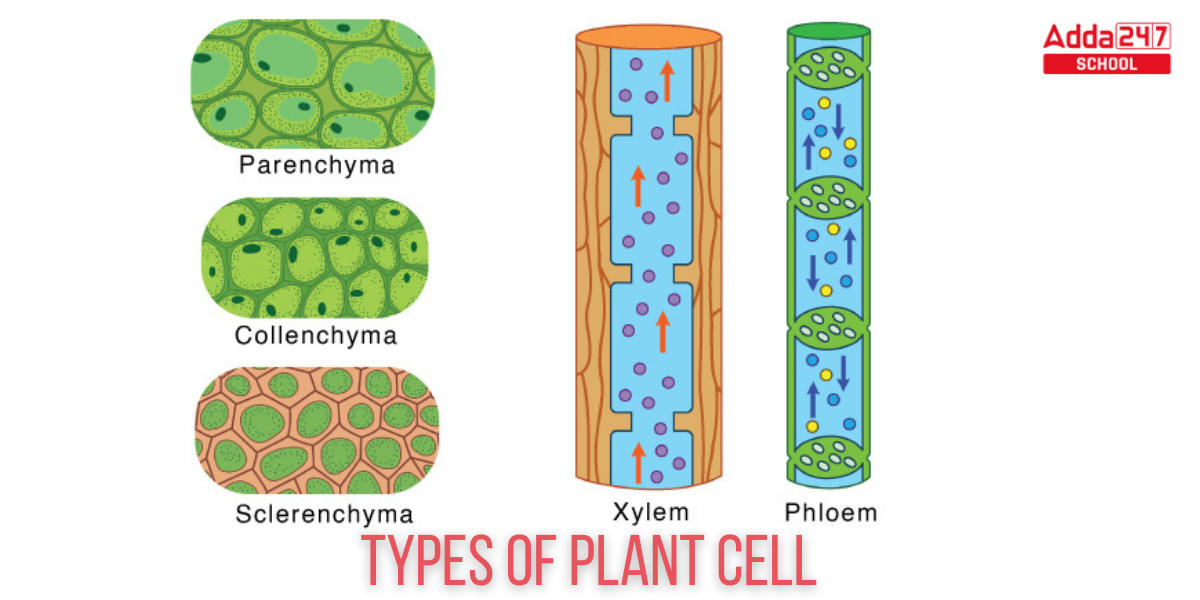
Xylem Plant Cell
Through the roots to the stem and leaves, xylem cells transport largely water and a few nutrients. In vascular plants, xylem cells serve as transporter cells.
Phloem Plant Cell
Phloem cells deliver photosynthesis-produced nutrients to all sections of the plant. They transmit sap, which is a sugary water solution.
Plant Cell Labelled Diagram
Here students can understand the cross-section and longitudinal view (Second-row images) of parenchyma, collenchyma, and sclerenchyma cells clearly with this following image. Different Plant Cell labelled Diagram follows.
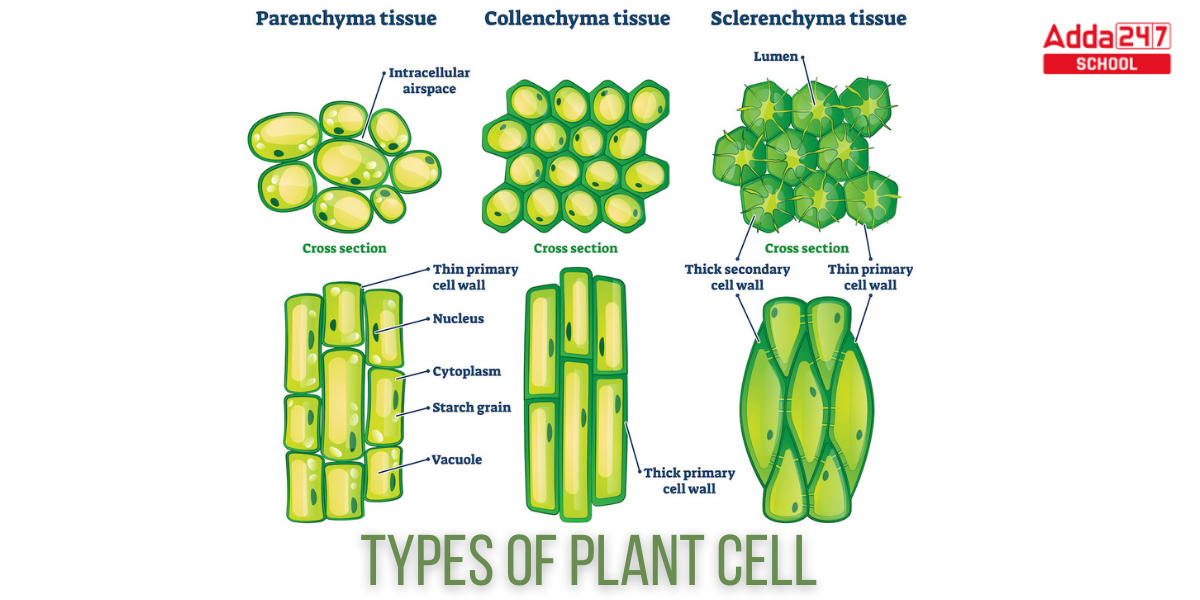
Plant Cell Structure
Plant cells contain a variety of components known as cell organelles. These organelles have a wide range of responsibilities which we will go through in depth. in the next section.
Cell Wall
The cell wall of a plant is a strong layer made of cellulose, glycoproteins, a substance called pectin, lignin, and hemicellulose that is found outside the cell membrane. Microtubules guide the creation of the cell wall, which has three layers: primary, secondary, and middle lamellae. Proteins, cellulose, and polysaccharides make up the cell wall.
Cell Wall Function: The major purpose of the cell wall is to defend and support the cell structurally, shield it from mechanical stress, and give it form and structure. The cell wall also filters molecules that pass through it and allows molecules to enter and exit the cell.
Cell Membrane
The cell membrane is a membrane that is semi-permeable and found in plant cells. It consists of a thin covering of protein and fat.
Function: It is one of the crucial organelles because it manages the entry and departure of various chemicals within the cell. Toxins are prevented from entering the cell, while nutrients and vital minerals are delivered across.
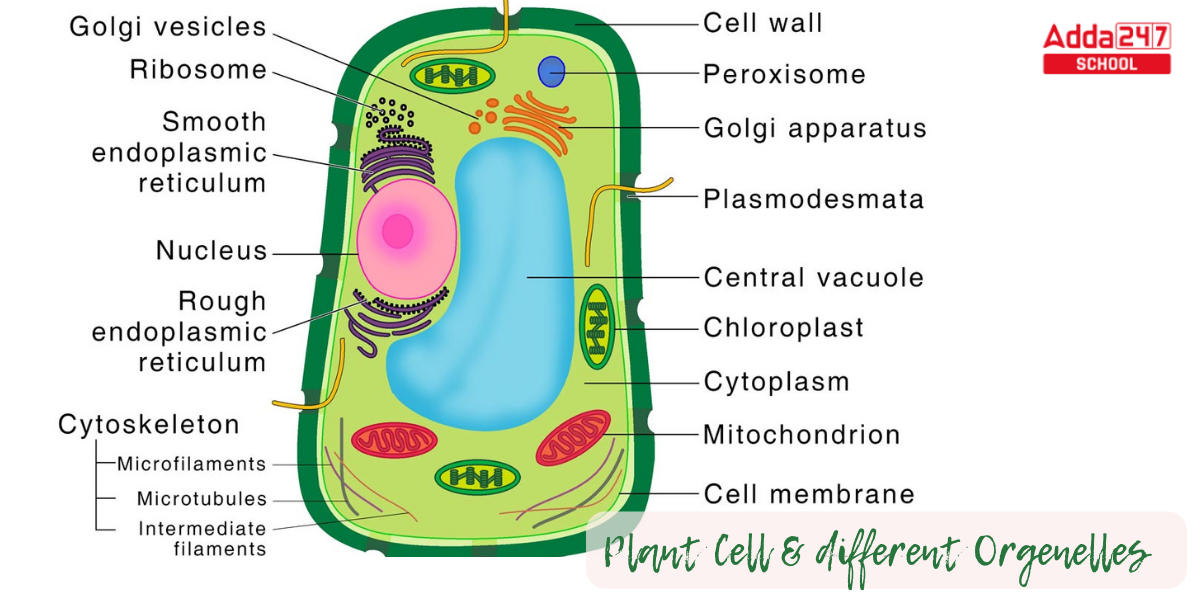
Nucleus
In eukaryotic cells, the nucleus is a membrane-based organelle. Eukaryotes contain a single nucleus in most cases, although some cell types, such as mammalian red blood cells, have no nuclei, while others, such as osteoclasts, have several. The nucleus is divided into two parts:
The Nucleolus: It aids in the formation of ribosomes and protein-making structures.
The Nucleopore: Holes in the nuclear membrane called nucleopores allow nucleic acids and proteins to pass across.
Function: This organelle aids in the production of ribosomes and protein-making structures, as well as the passage of proteins and nucleic acids.
Plastids
Plastids are double-membranous organelles present in the cells of plants and algae. Plasmid pigments not only aid in photosynthesis but can also modify the colour of the cell. It is essential for photosynthesis.
Function: These organelles are essential in the production and storage of food. It also contains pigments that aid in the photosynthesis process.
We will need to delve into greater detail to comprehend the many sorts of plastids. Plastids are classified as follows:
Leukoplast
They are found in non-photosynthetic plant tissue. They are utilised to store protein, lipids, and carbohydrates.
Chromoplast
They are a multicoloured, heterogeneous plastid that is responsible for pigment synthesis and storage in photosynthetic eukaryotic species. They have red, orange, and yellow pigments that colour all the ripe fruits and flowers we see in our daily lives.
Chloroplast
These chloroplasts are disk-shaped organelles with a double membrane around them. The chlorophyll molecule found in the chloroplast is also responsible for the green colour of plants.
- The outer membrane forms the chloroplast’s exterior surface and is relatively accessible to tiny molecules, allowing things to enter the organelle. The inner membrane is more resistant to foreign substances than the outer membrane. A narrow intermembranous gap of around 10-20 nanometers width exists between the outer and inner membranes.
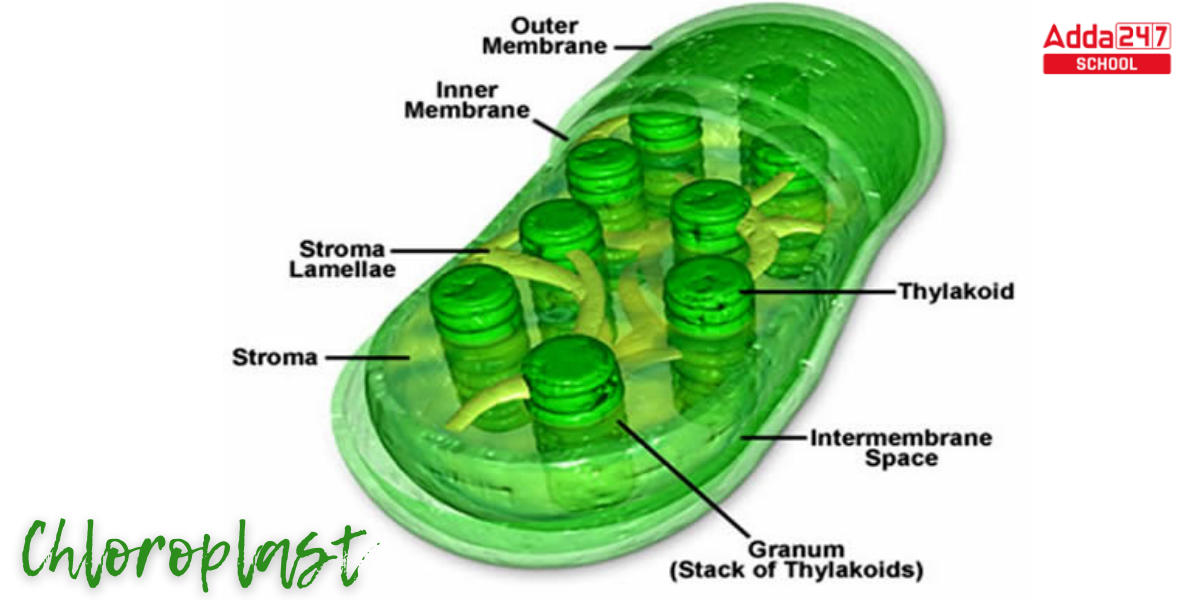
- The stroma is a fluid matrix that surrounds the centre of the chloroplast and is contained by the double membrane.
- Many structures termed thylakoids, which resemble flattened discs, are seen inside the stroma. In vascular plants, thylakoids are piled on top of each other in stacks known as great. Thylakoids include a high concentration of chlorophyll and carotenoids, which are pigments which absorb solar light energy.
- Chloroplasts are unique organelles found solely in plants and some algae. These organelles carry out photosynthesis, which converts water, carbon dioxide, and sunlight into nutrients that the plant can use to generate energy. Certain plant cells can have up to a hundred chloroplasts.
Central Vacuole
It takes up around 30% of the volume of an aged plant cell. The tonoplast is the membrane that encircles the core vacuole. They can be present in the cells of a wide range of organisms. Plant cells, on the other hand, have a huge vacuole that is capable of taking up anywhere from 30% to 90% of the entire cell volume.
Function: Apart from storage, the central vacuole’s primary role is to maintain turgor pressure on the cell wall. The middle vacuole is made up of cell sap. It is made up of salts, enzymes, and other ingredients.
Ribosomes
They are the tiniest membrane-bound organelles, containing RNA and protein. Ribosomes are also known as “Protein Factors of the Cell.” Because they are the locations of protein production, they are also known as the cell’s protein factories.
Function: Ribosomes are macromolecular machines that synthesise biological proteins.
Mitochondria
In the cytoplasm of all eukaryotic cells, they are the double-membraned organelles. Mitochondria are double-membrane organelles that are oval and tubular in shape. They generate energy by breaking down glucose and sugar molecules, which is why they are also known as the “Powerhouse of the Cell.”
Function: Its function is to generate energy by breaking down carbs and sugar molecules.
Golgi Apparatus
They are found in all eukaryotic cells and are important in the distribution of synthesised macromolecules throughout the cell. It is made up of a succession of stacked and flattened pouches known as Cisternae. The Golgi apparatus is also called the Golgi Complex and Golgi Body.
Function: Distributes synthesised macromolecules to various areas of the cell.
Lysosome
Lysosomes are known as suicide sacks because they contain digestive enzymes within a confined membrane. Lysosomes do not have a specific structure and seem spherical or granular.
Function: They dispose of cellular trash by digestion of worn-out organelles, food particles, and foreign items in the cell. The vacuoles perform the function of lysosomes in plants.
Plant Cell Functions
Plant cells are the basic structural and functional units of plants. They perform a variety of functions that are essential for the growth, development, and survival of plants. Here are some key functions of plant cells:
- Photosynthesis: Plant cells contain chloroplasts, which are responsible for photosynthesis. During photosynthesis, plants capture sunlight and use it to convert carbon dioxide and water into glucose (a form of sugar) and oxygen. This process provides energy and food for the plant and releases oxygen into the atmosphere.
- Cell Wall: Plant cells have a rigid cell wall made of cellulose. The cell wall provides structural support and protection to the cell, helping the plant maintain its shape and resist external pressures.
- Cellular Respiration: Plant cells undergo cellular respiration, a process that breaks down glucose to release energy for various cellular activities. While photosynthesis primarily occurs in the chloroplasts, cellular respiration occurs in the mitochondria of plant cells.
- Storage: Plant cells store various substances such as starch, proteins, and fats. These stored materials serve as energy reserves for the plant during times of growth, development, or when resources are scarce.
- Transport of Nutrients and Water: Plant cells are interconnected by a network of tubes called xylem and phloem. Xylem transports water and minerals from the roots to the rest of the plant, while phloem transports sugars and other organic compounds from the leaves to other parts of the plant.
- Synthesis of Organic Molecules: Plant cells synthesize a range of organic molecules, including proteins, lipids, and enzymes, which are crucial for various cellular functions.
- Cell Division and Growth: Plant cells divide and differentiate to allow for growth and development. Meristematic tissues, found in regions such as the tips of roots and shoots, continuously divide, giving rise to new cells that contribute to the plant’s growth.
- Protection and Defense: Plant cells produce secondary metabolites such as alkaloids and phenolic compounds that help protect the plant from herbivores, pathogens, and environmental stresses.
- Sensory Perception: Plant cells can sense and respond to external stimuli like light, gravity, and touch. This helps plants adjust their growth and development in response to changing environmental conditions.
- Reproduction: Plant cells are involved in plant reproduction. Reproductive structures like flowers and cones are composed of specialized cells that facilitate pollination, fertilization, and seed production.
- Water Regulation: Plant cells have specialized structures called vacuoles that store water and ions. They help maintain the turgor pressure within the cell, allowing the plant to stand upright and preventing wilting.
These functions collectively enable plants to survive, thrive, and contribute to the ecosystems they inhabit. Different types of plant cells, such as parenchyma, collenchyma, and sclerenchyma cells, have specific adaptations that make them suitable for their respective functions within the plant’s overall physiology.

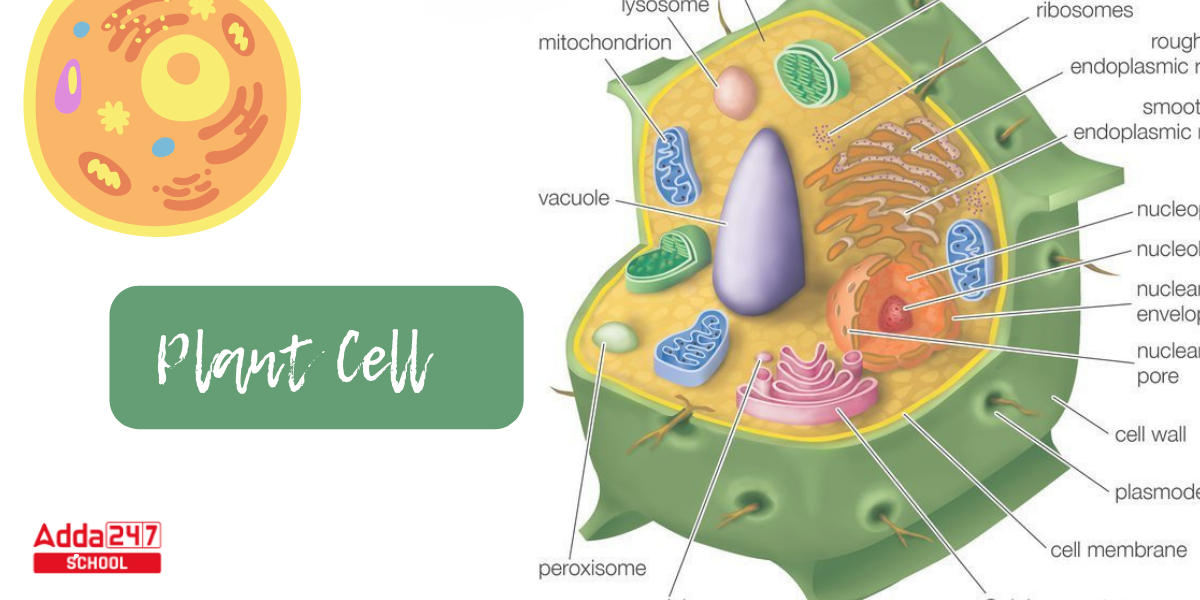







 BTEUP Result 2025 Out at bteup.ac.in, Do...
BTEUP Result 2025 Out at bteup.ac.in, Do...
 SGBAU Result 2025 Out, Check Summer Seme...
SGBAU Result 2025 Out, Check Summer Seme...
 How To Prepare for CUET Accountancy Exam...
How To Prepare for CUET Accountancy Exam...









